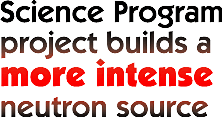


The Environmental Management Science Program, a partnership between the Office of Environmental Management and the Office of Energy Research, was chartered by Congress in 1996 to fund targeted research for the development of breakthrough approaches for solving DOE’s environmental problems with less expense, on accelerated schedules, and at less risk to workers and the public. EMSP projects provide EM with basic research for fundamental data that may be critical to advancing technologies under development but not yet implemented, and they generally address problems considered intractable without new knowledge. EMSP projects are typified by the High-Fluence Neutron Source for Nondestructive Characterization of Nuclear Waste under development at Los Alamos National Laboratory. The goal of this project is to build an economical, compact, and transportable yet intense neutron source for applications in assaying nuclear and chemical waste, detecting high explosives, and supporting safeguards and nonproliferation applications. Potential EM applications include characterizing transuranic wastes, particularly remote-handled wastes, for the Waste Isolation Pilot Plant and measuring high-level wastes, cemented or vitrified wastes, and residues prior to stabilization and disposal. Existing technology is insufficient to measure these contaminants because it addressed a substantially different technical problem: the measurement of very pure material. However, the present need is to develop measurement capability for highly impure, contaminated, and heterogeneous wastes and residues of the production process. One problem in particular is the measurement of wastes with very high radiation (neutron) backgrounds. These measurement conditions demand measurement capabilities several orders of magnitude above existing capabilities. An intense neutron source directly addresses the need to characterize nuclear materials under difficult measurement conditions. The benefit of this approach is that mature, neutron-based, nondestructive characterization methods can be used, but their capabilities will be increased by the same amount as the increase in neutron intensity. The proposed neutron source could extend existing instrumentation sufficiently to meet these requirements. The LANL team is researching the basic plasma physics necessary to develop a high-fluence neutron source based on the inertial electrostatically confined (IEC) plasma. This technology has potential for immediate application as a portable neutron source. IEC devices have significant advantages over present neutron sources in both cost and safety. The project goal is to develop a source that produces 1011 neutrons/second with a cost, weight, and size comparable to current systems, which are three orders of magnitude less powerful.
Early experimentation showed that neutron yield scaled inversely with density. In collisional operations, accelerated ions are likely to collide with fill gas neutrals in the accelerating grid interior. Therefore, the ions never achieve the full accelerating potential of the grid. A novel approach proposed at LANL removes this limitation by using a triple grid design, in which the inner grid is the accelerating grid. It is raised to high negative potential and serves the same function as the single grid in conventional IEC systems. The central grid serves as electrical isolation and is held at ground potential. The outer grid is raised to a modest positive potential.
The LANL project team has completed construction of the IEC device, and all systems are fully functional. Experimental operations are under way to "tune" the system to deal with plasma arcing problems and to raise the main accelerating voltage to its full 75-kilovolt potential. The design goal of this phase is production of 109 n/s, operating in pure deuterium, which can be vented in a normal vacuum system. Principal investigator Mark Pickrell expects the system to achieve this goal in the early months of 1999. Once operating parameters are established, the working design will be frozen, and tritium operations will begin. Since tritium is radioactive, the system will be completely sealed, and the vacuum system will no longer vent. This operating regime should generate the ultimate goal of 1011 n/s. The LANL project team would eventually like to see an industrial private-sector partner convert the IEC system from a laboratory experiment to an commercially available industrial machine. For more information about the High-Fluence Neutron Source for Nondestructive Characterization of Nuclear Waste project, contact Mark Pickrell at LANL, (505) 665-5098, mpickrell@lanl.gov. |